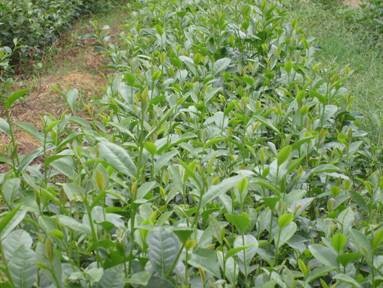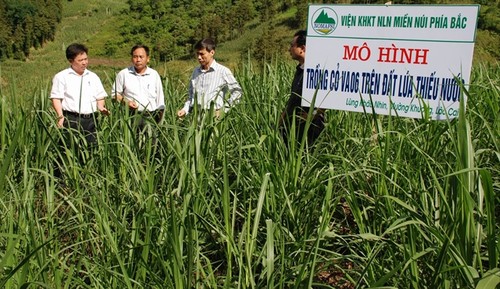(VOVworld) - Agriculture is one of the sectors most affected by climate change, with agricultural lands narrowed, productivity considerably reduced, and the life of farmers affected. Science and technology are being applied to deal with the situation. In recent years, the Northern Mountain Agriculture and Forestry Science Institute (NOMAFSI) in Phu Tho province has done a lot of research and created models for sustainable agricultural production in response to climate change.
 |
Rows of Shan tea trees in the tea areas of NOMAFSI shoot out bright green buds in the cold winter weather. Shan tea is a precious tea variety of the mountainous area in the North of Vietnam where the climate is mainly tropical monsoon. Shan tea is one of several tea varieties being studied by NOMAFSI because it grows in areas of Vietnam that have variable weather. Luu Ngoc Quyen, NOMAFSI’s Deputy Head, told us: “This is a shan tea variety of the mountainous area. This kind of plant is resistant to cold weather. We brought it to lower elevations and adapted it to the weather here. So during the cold weather that begins in September, we still have shan tea in this area. Shan tea is not only resistant to cold and dry weather but also generates good income. This is a good solution for dry weather and soil and helps farmers earn a stable income”.
At NOMAFSI, around 200 tea varieties are preserved. The Institute is currently doing research on 8 of them. Tea plants from tea hubs in Vietnam, China, Taiwan, and Japan have been collected, studied and provided to farmers in areas with different weather such as Phu Tho, Yen Bai, Nghe An, Lam Dong and Quang Ninh.
Beside tea research and experiments on sustainable tea cultivation, the Integrated Production Model of combining livestock and crops is a climate change response model NOMAFSI is working on. Mr. Quyen again: “We are planting high-yield VA06 grass which is suitable for animal husbandry. VA06 generates 100 – 300 tons of grass per hectare every year. On 1 hectare, we can raise 20 – 25 cows. Each cow generates 20 million VND, so 20 cows can bring much higher income than growing cassava, rice or maize. In this model, on the upper land we plant orchards, which not only creates shading but also retains water in the soil. There is a path the cows follow to go to the orchard. There, the cows wander round and their dung enriches the soil”.
This model is a closed chain which makes full use of husbandry and growing fruit trees and helps deal with animal dung, a major source of environmental pollution in rural areas.
With climate change causing changes in temperature and soil, since 2006, NOMAFSI has been collecting rice seeds from Vietnam, China, and the Philippines to select the 8 high-yield rice varieties most resistant to drought. According to Quyen, they need to select the varieties most able to resist changeable weather: “One way to deal with climate change is to find varieties which are highly adaptable to weather changes. Normally, the indigenous varieties are the most adaptable because they have been grown for a long time and are closely adapted to the weather in a certain area. However, the quality of those varieties has gradually degraded over time. Our Institute is studying ways to preserve the indigenous varieties while developing new cultivation methods for growing them”.
 |
The Institute has sponsored many activities to introduce new technology and new agricultural models to the farmers: “After research, we piloted new agricultural models in the farmers’ own fields, so they could see the results with their own eyes, assess efficiency, and choose models that suit their conditions. We also organize training courses to help farmers apply new technology and models”.
As an agency of the Ministry of Agriculture and Rural Development, NOMAFSI has done a lot of scientific research on agriculture and forestry, helped to select, transfer and duplicate high-yield varieties, made full use of natural resources, and protected the environment.